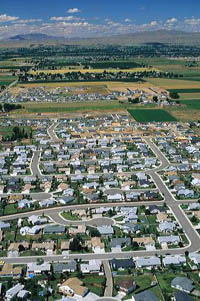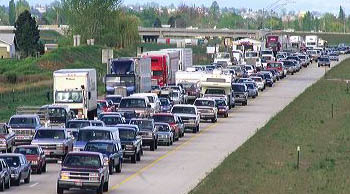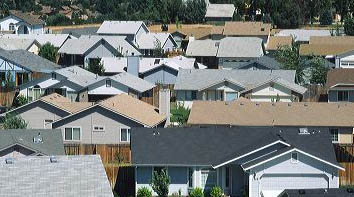Growth
Stop This Insanity Now!
Kuna has run out of sewer capacity, Meridian has run out of classrooms, Eagle Road is a parking lot, Boise needs code enforcement and all these cities battle one another to see who can grow the most and the fastest.
Then they all want to get together and pay big bucks to “consultants” who will tell us all how to “manage growth.” It’s simple folks: STOP EATING!
Somehow the cities and counties of the Treasure Valley have all resigned themselves to certain “facts” which are not necessarily true like:
–You can’t tell someone what to do with their property. UNTRUE–we have had zoning laws for years.
–People love it here, you can’t stop them from coming. If they don’t have a place to poop or a classroom for their kids, they won’t love it so much.
–Increased tax base means more money for government services. It means more people and the problems they bring.
The unbridled growth we have experienced over the past 5 or 10 years will be the death of us all unless it is limited or stopped now.
When a farmer wants to rezone and subdivide his land, cities rush to annex it before their neighbors get that “valuable tax base”. Cities all compete to see who can be the most “business friendly” and they eagerly welcome new companies to their towns…along with more traffic, children in schools, people pooping in the sewers, and all that goes with it.
And it is all justified with, “This is nothing you ought to see Los Angeles or Denver where we used to live.” The create what they seek to flee. On a smaller scale those who flee Boise create the same in Kuna.
Folks don’t come to the Boise area for well engineered traffic signals, good code enforcement, high density in-fill, cops in every school. They come because it is cheap and there is plenty of OPEN SPACE! You don’t see brochures and web sites with pictures like those with this article. You seldom hear anyone say, “I wish my neighbors were 12 feet closer and the street was 8 feet narrower, and there were 10 more kids in my son’s classroom.”
Here are some quick solutions:
–IMPACT FEES–charge up to $15,000 per house and much more for businesses to even build a structure.
–Make no changes to current zoning and allow no “variances” for two years.
–Let infrastructure and services catch up with current demands before adding any new demands.
–In short, make growth pay, or don’t grow. That will slow things a bit and also relieve some of the growing pains.
–Either build some high volume roads or require people to live where they work. Creating low paying jobs along with high value residences spells disaster. Worker bees fly west after work and east to the hive every day.
We have built a local economy based on expansion. The farmer, developer, contractor, supplier, banker, landscaper, and government all benefit from this insane growth, but it cannot go on forever. When the boom turns to bust, these folks will move on to the next gold rush and leave a tattered ruins behind.
We need a “time out” so we can catch or collective breath.
To insure more advertising-free Boise Guardian news, please consider financial support.
 July 5, 2005
July 5, 2005 
Jul 7, 2005, 4:39 am
One wonders how a person could possibly think so intellegently!
I agree they need to slow the growth . New constrution should be paying the cost of developing the infrastructure. All these $10 an hr jobs at call center’s our govenor is so proud of can’t support goverment after the boom is over, and the building boom will end. The day will come.
Jul 16, 2005, 11:09 pm
I am tired of growth in the valley but don’t necessarily see it ending anytime soon. Look at So Cal, Phoenix, and Vegas. They have been growing like crazy for years and haven’t had their real estate “bubbles” burst yet. And AZ and NV are right to work states as well.
Aug 5, 2005, 10:10 am
Development Impact Fees; Synopsis of Findings
Purpose
• Promote methodical growth and development by establishing uniform standards
• Those who benefit from growth and development pay proportionate share of the cost for sustainability of public facilities
• All fees collected are required to be used within the service area collected
Concept
• Guarantee that new developments within the State of Idaho pay their proportionate share of the cost to system maintenance to serve the proposed development
• Detailed calculations for development impact fees shall be provided in accordance with generally accepted accounting principles
• Incidental benefits to other owners or developers from development impact fees within a service area does not invalidate the development impact fees
Methodology
• Development impact fees are calculated on the basis of Levels of Service for public facilities
• Increases in public facilities capacity, estimated demand, and levels of service are reflected in new development impact fees
• Methodology must be detailed in the governmental entities capital improvement plan
Example of ACHD Formula for development impact fees
• Transportation impact fees= VMT Cost X (New Trip X Ave. Trip Length X Network) X PM Peak Hours
1) Residential development impact fees- Single family $1,185 per unit, Apartment $728 per unit, Mobile Home $692 per unit
2) Hotel/Motel development impact fees- Hotel $692 per room, Motel $552 per unit
3) Commercial development impact fees- Bank- Drive Thru $7,112 per 1000 sq. ft., Hospital $1,385 per 1000 sq. ft., Manufacturing $868 per 1000sq. ft., Restaurant $2,481 per 1000sq. ft., Supermarket $1,962 per 1000 sq. ft.
4) Office Development impact fees- General Office $1,749 per 1000 sq. ft., Medical/Dental $4,366 per 1000 sq. ft.
5) Misc. development impact fees- Gas Station $1,727, Golf Course $3,215, Movie Theater $82, Public Park (city) $75, Self-Serve Car Wash $943
o A new Supermarket development that is 60,000 sq. ft. would have to pay $117,720 in development impact fees, to be collected when the developer/owner is issued a building permit.
o A new Dentist Office that is 6000 sq. ft. would owe $26,196 in development impact fees
o A new 18 hole Golf Course would owe $57,870 in development impact fees
Note: These examples from the Ada County Highway District are only from one of four service areas within ACHD jurisdiction. Development impact fees vary from each service unit as the formula coefficients adjust to each service areas characteristics.
Collection of Development Impact Fees
• The payment of impact fees and any extraordinary impacts are due at the time of the issuance of the building permit
• Failure to pay impact fees when due result in the following, but not limited to:
o Additions to the fee for reasonable interest and penalties for non of late payment
o Withholding of the building permit or other governmental approval until development impact fee is paid
o Withholding utility service
o Imposing liens following procedures contained in chapter 5, title 45, Idaho Code
Revenue examples
• Ada County Highway District reported $5.06 million in revenue from impact fees for FY 2003.
• ACHD estimates $6 million in revenue for FY 2004, 9.8% of total revenue. $2.5 million of estimated revenue from impact fees is devoted to corridor preservation
• ACHD forecasts revenue from impact fees over $8.7 million by FY 2008
• 2004 Idaho Economic Forecast estimates Housing Starts of 15,810 in 2004, 15,092 in 2005, and 14,583 new units for 2006
• Using a similar formula as ACHD, if Idaho Transportation Department assessed impact fees on all single unit housing starts projected for 2004, estimated revenues from development impact fees would total $15.6 million
• Number of commercial buildings within the state; examples not yet found. Hypothetically: 20 new supermarkets with average size of 60,000 would generate an estimated $2.4 million in revenue
List of Cities, Counties, and Highway Districts Reporting Impact Fees 2003
CITIES
• COEUR D ALENE
• HAILEY
• HAYDEN
• POST FALLS
• RICHFIELD
• SHOSHONE
o TOTALING $1,465,691
COUNTIES= 0
HIGHWAY DISTRICTS
o POST FALLS HD
o ADA COUNTY HD
o TOTALING $6.6 million
First year for recorded impact fees was 1995, $2.2 million
Bottom line: Development Impact Fees are economically efficient, and promote sustainable growth, strategically.
ED not: This guy is new to the GUARDIAN, but seems to have lots of info. Welcome aboard Jay!